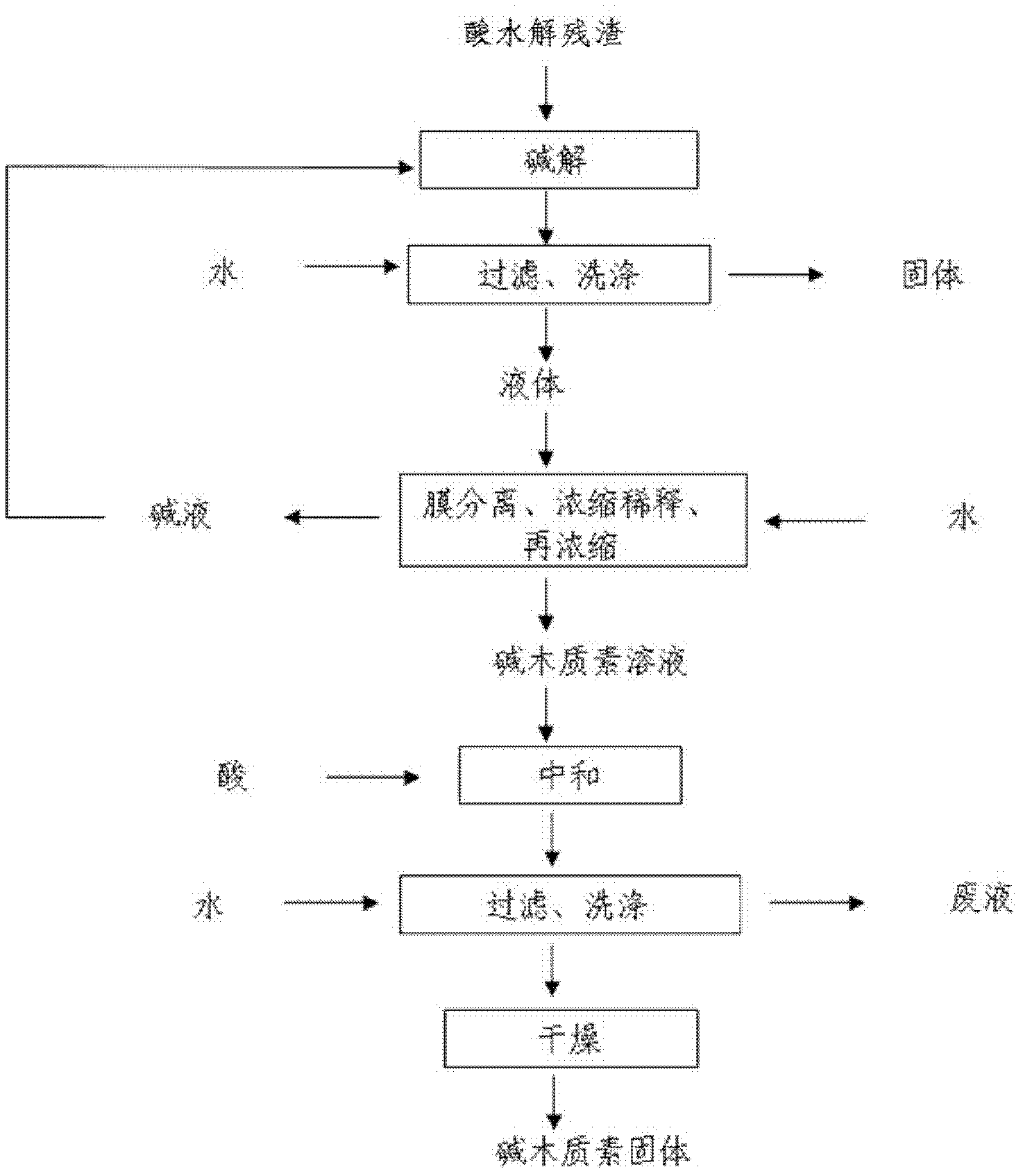Comprehensive utilization method of lignocellulose biomass
A lignocellulose and biomass technology, applied in the field of comprehensive utilization of cellulose, hemicellulose and lignin in lignocellulosic biomass, can solve the problem of low enzymatic extraction rate of cellulose, cellulose, hemicellulose and lignin In order to improve the extraction rate, reduce damage and increase the solid content
- Summary
- Abstract
- Description
- Claims
- Application Information
AI Technical Summary
Problems solved by technology
Method used
Image
Examples
Embodiment 1
[0070] (1) Alkali solution to extract alkali lignin
[0071] 10.65kg of corncobs (mass composition: moisture 6.12%, cellulose 35.19%, hemicellulose 32.01%, lignin 23.7%, other 2.95%, the same below) are pulverized and then mixed with alkali solution, wherein the volume of liquid and solid The ratio is 5: 1, the concentration of sodium hydroxide is 6%, then the temperature is raised to 70° C., after 1 hour of cooking and alkali hydrolysis, the alkali hydrolysis residue and alkali lignin solution are separated, and the alkali hydrolysis residue is washed with 10 kg of water. The cleaning solution is combined with the alkali lignin solution; 20.38kg of alkali hydrolysis residue (moisture content is about 65%) and 49.61kg of alkali lignin solution are finally obtained; after the alkali lignin solution is separated and concentrated by membrane equipment, add 10kg of water to dilute , Concentrate again, finally obtain 6.29kg of alkali lignin concentrate, and reclaim 53.32kg of alkal...
Embodiment 2
[0084] (1) Alkali solution to extract alkali lignin
[0085] Raw material and method are identical with embodiment 1 step (1), and difference is, liquid-solid volume ratio is 20: 1, and the concentration of sodium hydroxide is 5%, and the temperature of alkaline solution treatment is 100 ℃, and the time is 2 hours. Finally, 19.29kg of alkali hydrolysis residue (with a water content of about 65%) and 6.75kg of alkali lignin concentrate were obtained, and 203.9kg of alkali liquor was recovered. The solid content of the concentrated solution is 25.2%, the alkali lignin content of the concentrated solution is 23.6%, the residual alkali content of the concentrated solution is 0.7%, and the ash content of the concentrated solution is 1.6%. The content of is 4.02%, and the recovery rate of alkali is 82%. The extraction rate of alkali lignin is 63%.
[0086] (2) acid hydrolysis
[0087] Get all the alkali hydrolysis residues obtained by the alkali solution treatment in the present ...
Embodiment 3
[0091] (1) Alkali solution to extract alkali lignin
[0092] Raw material and method are identical with embodiment 1 step (1), and difference is that liquid-solid volume ratio is 10: 1, and the concentration of sodium hydroxide is 8%, and the temperature of alkaline solution treatment is 40 ℃, and the time is 6 hours. Finally, 21.47kg of alkali hydrolysis residue (with a water content of about 65%) and 5.98kg of alkali lignin concentrate were obtained, and 97.87kg of alkali liquor was recovered. The solid content of the concentrated solution is 25.7%, the alkali lignin content of the concentrated solution is 24.1%, the residual alkali content of the concentrated solution is 0.5%, and the ash content of the concentrated solution is 1.6%. The content is 6.95%, and the recovery rate of alkali is 85%. The extraction rate of alkali lignin is 57%.
[0093] (2) acid hydrolysis
[0094] Get all the alkali hydrolysis residues obtained by the alkali solution treatment in the present ...
PUM
 Login to View More
Login to View More Abstract
Description
Claims
Application Information
 Login to View More
Login to View More - R&D
- Intellectual Property
- Life Sciences
- Materials
- Tech Scout
- Unparalleled Data Quality
- Higher Quality Content
- 60% Fewer Hallucinations
Browse by: Latest US Patents, China's latest patents, Technical Efficacy Thesaurus, Application Domain, Technology Topic, Popular Technical Reports.
© 2025 PatSnap. All rights reserved.Legal|Privacy policy|Modern Slavery Act Transparency Statement|Sitemap|About US| Contact US: help@patsnap.com



